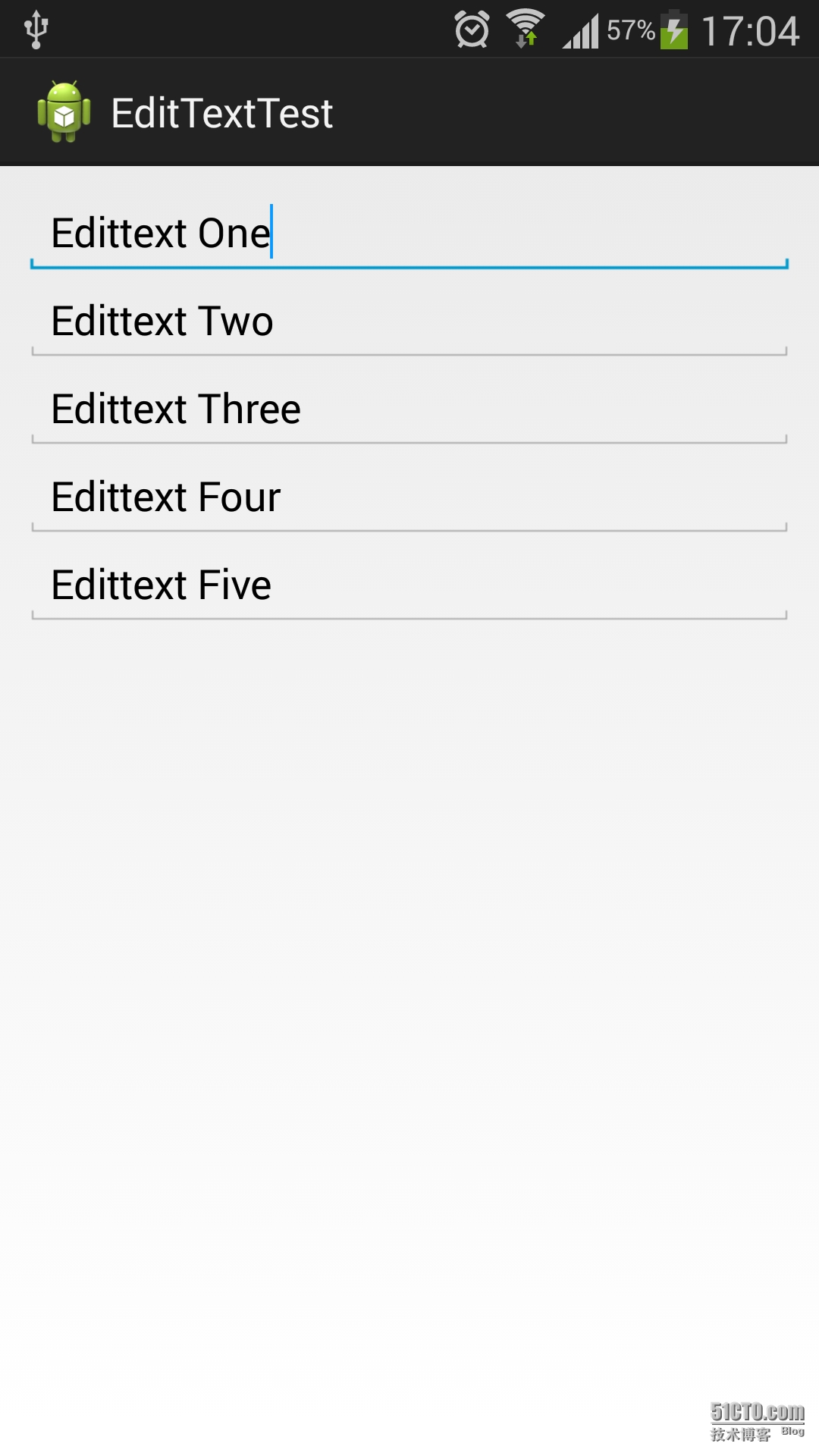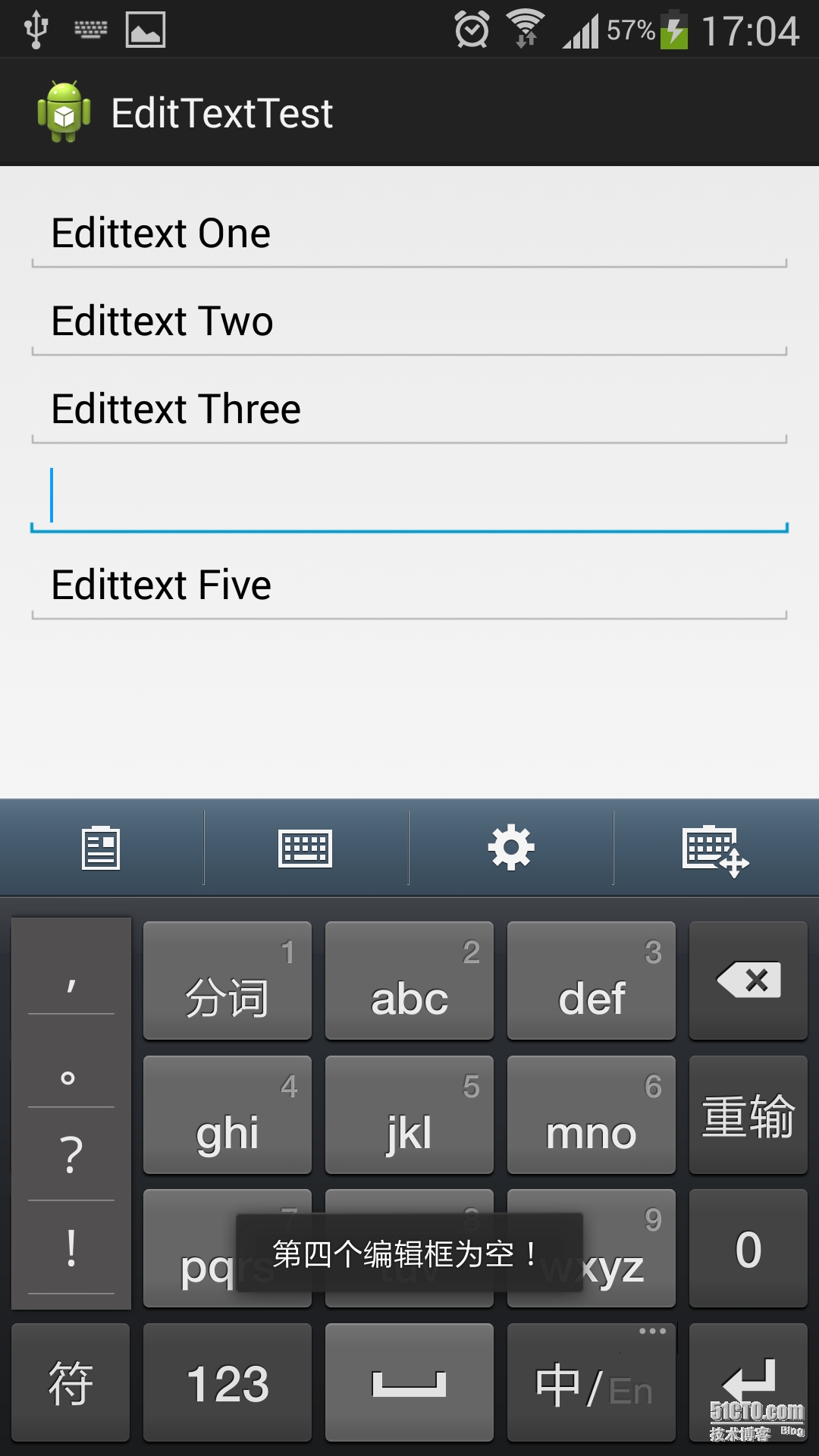首页 > 代码库 > TextWatcher如何找到调用它的EditText
TextWatcher如何找到调用它的EditText
和我在南方一起工作的朋友说,“南北方的差异其实蛮大的。”我家在北方,也在南方工作,不过我倒是觉得差异不怎么大,因为我在北方的时候,就没有女朋友,而来到了南方,同样没有女朋友。
开发时遇到一个问题,如同标题,当一个类继承了TextWatcher时,倘若这个类中有很多EditText控件,那么如何知道调用TextWatcher的是哪一个EditText控件呢?如果一个类继承的是OnClickListener,那可以通过View获取控件的Id值,从而分辨控件,做对应操作。可惜TextWatcher似乎没有类似的方法。我是这样解决的:
布局文件:
<LinearLayout xmlns:android="http://schemas.android.com/apk/res/android" xmlns:tools="http://schemas.android.com/tools" android:layout_width="match_parent" android:layout_height="match_parent" android:orientation="vertical" android:padding="10dp"> <EditText android:id="@+id/edit1" android:layout_width="match_parent" android:layout_height="wrap_content" android:text="@string/edittext_1" /> <EditText android:id="@+id/edit2" android:layout_width="match_parent" android:layout_height="wrap_content" android:text="@string/edittext_2" /> <EditText android:id="@+id/edit3" android:layout_width="match_parent" android:layout_height="wrap_content" android:text="@string/edittext_3" /> <EditText android:id="@+id/edit4" android:layout_width="match_parent" android:layout_height="wrap_content" android:text="@string/edittext_4" /> <EditText android:id="@+id/edit5" android:layout_width="match_parent" android:layout_height="wrap_content" android:text="@string/edittext_5" /> </LinearLayout>
很简单,只是写了几个EditText控件。
主类:
package com.example.edittexttest;
import android.app.Activity;
import android.os.Bundle;
import android.text.Editable;
import android.text.TextWatcher;
import android.view.View;
import android.widget.EditText;
import android.widget.TextView;
import android.widget.Toast;
public class EditTextTest extends Activity {
EditText edit1, edit2, edit3, edit4, edit5;
@Override
protected void onCreate(Bundle savedInstanceState) {
super.onCreate(savedInstanceState);
setContentView(R.layout.activity_edit_text_test);
edit1 = (EditText) findViewById(R.id.edit1);
edit1.addTextChangedListener(new ClassOfTextWatcher(edit1));
setCursorToEnd(edit1);
edit2 = (EditText) findViewById(R.id.edit2);
edit2.addTextChangedListener(new ClassOfTextWatcher(edit2));
setCursorToEnd(edit2);
edit3 = (EditText) findViewById(R.id.edit3);
edit3.addTextChangedListener(new ClassOfTextWatcher(edit3));
setCursorToEnd(edit3);
edit4 = (EditText) findViewById(R.id.edit4);
edit4.addTextChangedListener(new ClassOfTextWatcher(edit4));
setCursorToEnd(edit4);
edit5 = (EditText) findViewById(R.id.edit5);
edit5.addTextChangedListener(new ClassOfTextWatcher(edit5));
setCursorToEnd(edit5);
}
private class ClassOfTextWatcher implements TextWatcher {
private TextView view;
public ClassOfTextWatcher(View view) {
if (view instanceof TextView)
this.view = (TextView) view;
else
throw new ClassCastException(
"view must be an instance Of TextView");
}
@Override
public void afterTextChanged(Editable s) {
if (s.length() <= 0) {
switch (view.getId()) {
case R.id.edit1:
Toast.makeText(EditTextTest.this, "第一个编辑框为空!",
Toast.LENGTH_LONG).show();
break;
case R.id.edit2:
Toast.makeText(EditTextTest.this, "第二个编辑框为空!",
Toast.LENGTH_LONG).show();
break;
case R.id.edit3:
Toast.makeText(EditTextTest.this, "第三个编辑框为空!",
Toast.LENGTH_LONG).show();
break;
case R.id.edit4:
Toast.makeText(EditTextTest.this, "第四个编辑框为空!",
Toast.LENGTH_LONG).show();
break;
case R.id.edit5:
Toast.makeText(EditTextTest.this, "第五个编辑框为空!",
Toast.LENGTH_LONG).show();
break;
default:
break;
}
}
}
@Override
public void beforeTextChanged(CharSequence s, int start, int count,
int after) {
}
@Override
public void onTextChanged(CharSequence s, int start, int before,
int count) {
}
}
//将编辑框的光标移动到末尾
public void setCursorToEnd(EditText text){
String content = text.getText().toString();
text.setSelection(content.length());
}
}写了一个叫“ClassOfTextWatcher”的内部类,它实现了TextWatcher接口,这个内部类的构造方法中传入View控件来获取控件的Id。
效果图:


本文出自 “皓轩” 博客,请务必保留此出处http://wy521angel.blog.51cto.com/3262615/1574681
TextWatcher如何找到调用它的EditText
声明:以上内容来自用户投稿及互联网公开渠道收集整理发布,本网站不拥有所有权,未作人工编辑处理,也不承担相关法律责任,若内容有误或涉及侵权可进行投诉: 投诉/举报 工作人员会在5个工作日内联系你,一经查实,本站将立刻删除涉嫌侵权内容。
